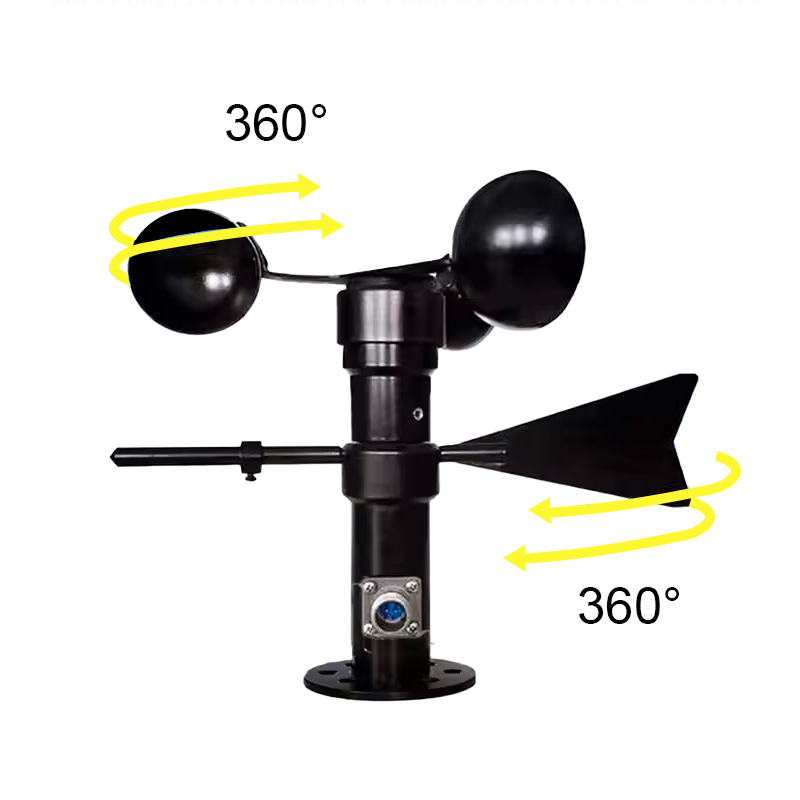Жаңартылатын энергия көздеріне әлемдік сұраныстың артуы аясында жел энергиясы энергияның таза және жаңартылатын түрі ретінде көбірек назар аудара бастады. Жел энергиясын өндіру, жел энергиясын пайдаланудың негізгі тәсілі ретінде, бірте-бірте бүкіл әлемде электр энергиясының маңызды көзіне айналуда. Жел электр станцияларын салу және пайдалану кезінде желдің жылдамдығы мен бағытын бақылау өмірлік маңызды болып табылады. Негізгі жабдық ретінде желдің жылдамдығы мен бағытының сенсорлары электр қуатын өндіру тиімділігін арттырып қана қоймайды, сонымен қатар жел электр станцияларының қауіпсіздігі мен сенімділігін арттырады.
Жел жылдамдығы мен бағыты датчиктерінің негізгі принципі
Жел жылдамдығы мен бағыты сенсоры желдің жылдамдығы мен бағытын анықтау арқылы нақты уақыттағы жел өрісі туралы ақпаратты алады. Бұл сенсорлардың әртүрлі жұмыс принциптері бар, соның ішінде ультрадыбыстық толқындар, термиялық пленкалар және динамикалық қысым сияқты әртүрлі әдістер. Желдің жылдамдығы мен бағытының деректерін электрлік сигналдарға түрлендіру арқылы жел электр станциялары энергияны жинау мен пайдалану жылдамдығын жақсарта отырып, нақты талдау мен шешім қабылдауды жүзеге асыра алады.
2. Жел жылдамдығы мен бағыты датчиктерінің артықшылықтары
Электр энергиясын өндіру тиімділігін арттыру
Желдің жылдамдығы мен бағыты жел электр станцияларының өнімділігіне әсер ететін маңызды факторлар болып табылады. Нақты уақыттағы бақылау арқылы желдің жылдамдығы мен бағыты датчиктер жел фермаларына климаттың өзгеруіне жақсы бейімделуге, жел турбиналарының жұмыс күйін оңтайландыруға және осылайша қуат өндіру тиімділігін арттыруға мүмкіндік береді.
Қауіпсіздік мониторингі
Жел жылдамдығы мен бағыты сенсорлары қатты жел мен дауыл сияқты төтенше ауа райы жағдайлары туралы ескертеді, жел электр станцияларына жабдықтың зақымдануын болдырмау және қауіпсіз жұмысты қамтамасыз ету үшін дер кезінде алдын алу шараларын қабылдауға көмектеседі.
Деректерге негізделген шешім қабылдау
Желдің жылдамдығы мен бағытының нақты деректері жел энергиясын өндіруді жоспарлауға, жобалауға және пайдалануға ғылыми негіз береді. Тарихи деректерді талдау арқылы электр станциясының менеджерлері неғұрлым ақылға қонымды инвестициялық және операциялық стратегияларды құра алады, тәуекелдерді азайтады және кірісті арттырады.
Жаңартылатын энергияның үлесін ұлғайту
Жел жылдамдығы мен бағыты датчиктерін қолдану арқылы жел энергиясын өндірудің болжамдылығы мен сенімділігі айтарлықтай артты, бұл бүкіл энергетикалық құрылымдағы жаңартылатын энергия үлесін кеңейтуге техникалық қолдау көрсетеді және жаһандық жасыл энергияға көшуге ықпал етеді.
3. Сәтті жағдайлар
Үйде және шетелде жел энергетикасының көптеген жобаларында желдің жылдамдығы мен бағыты датчигі таптырмайтын негізгі жабдыққа айналды. Мысалы, Австралиядағы үлкен жел паркі жетілдірілген жел жылдамдығы мен бағыты сенсорларын орнатқаннан кейін нақты уақытта жел паркінің динамикасын бақылаған. Жүйені оңтайландырудан кейін электр қуатын өндіру 15%-дан астамға өсті. Мұндай сәтті жағдайлар практикалық қолдануда жел жылдамдығы мен бағыты сенсорларының үлкен құндылығын дәлелдейді.
4. Болашаққа болжам
Технологияның дамуымен желдің жылдамдығы мен бағыты датчиктерінің технологиясы жетілген және олардың функциялары әртүрлі болады. Болашақта олар жел энергиясын өндіруді интеллектуалды басқарудың жоғары деңгейіне жету үшін жасанды интеллектпен және үлкен деректерді талдаумен біріктірілуі мүмкін. Мысалы, метеорологиялық ақпаратты жан-жақты талдау арқылы жел электр станциялары жел энергиясы ресурстарының өзгеру тенденциясын алдын ала болжай алады және тиімдірек жұмыс стратегиясын тұжырымдай алады.
Қорытынды
Жел энергиясын өндіру жаһандық климаттық өзгерістерді шешудің және тұрақты дамуға қол жеткізудің маңызды жолы болып табылады. Желдің жылдамдығы мен бағытының сенсоры жел электр станцияларының жұмыс тиімділігін арттыру және қауіпсіздігін қамтамасыз етудің маңызды кепілі болып табылады. Біз жел энергетикасы кәсіпорындары мен инвесторларын жоғары сапалы жел жылдамдығы мен бағыты датчиктеріне назар аударуға және енгізуге, жел энергиясын дамыту мен қолдануды бірлесіп ынталандыруға және адамзаттың тұрақты болашағына үлес қосуға шақырамыз.
Жел жылдамдығы мен бағыты сенсорын таңдап, жасыл энергияның жаңа дәуірін бірге қарсы алайық!
Хабарлама уақыты: 14 мамыр 2025 ж


